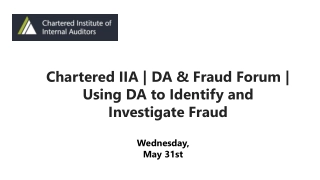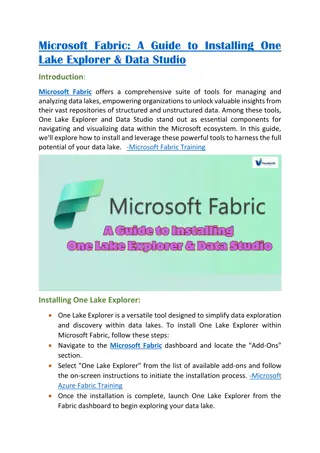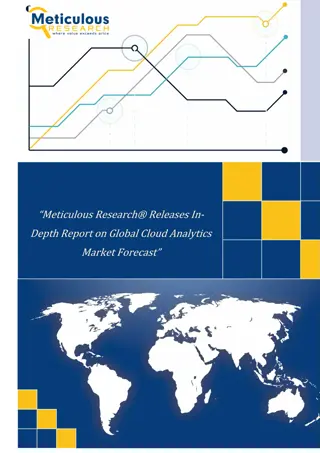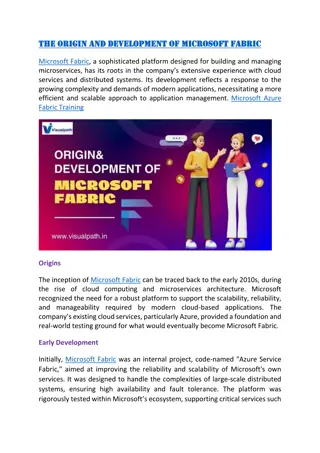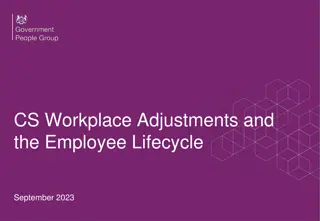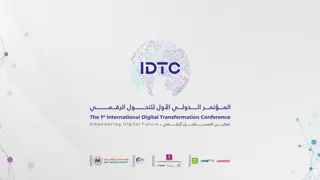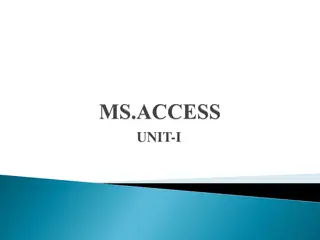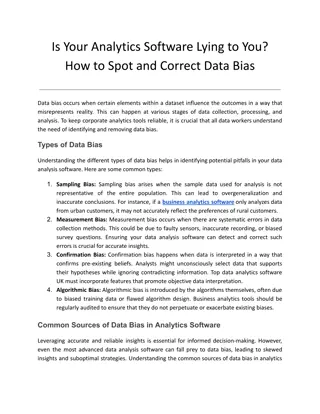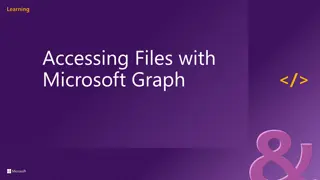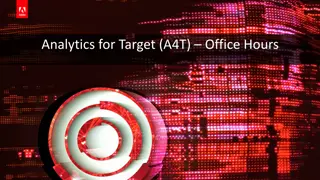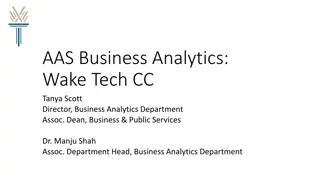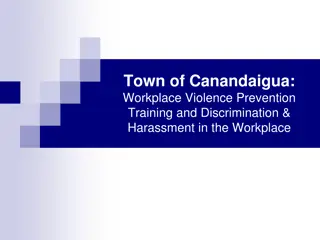Microsoft Workplace Analytics
Discover the comprehensive guide for rolling out Microsoft Workplace AnalyticsManager insights, providing valuable strategies and practical insights to maximize productivity and efficiency within your organization. This guide encompasses detailed steps, best practices, and implementation techniques essential for successful deployment and utilization of Workplace AnalyticsManager insights. Learn how to leverage data-driven insights to optimize workplace performance and drive informed decision-making across your teams.
Download Presentation

Please find below an Image/Link to download the presentation.
The content on the website is provided AS IS for your information and personal use only. It may not be sold, licensed, or shared on other websites without obtaining consent from the author.If you encounter any issues during the download, it is possible that the publisher has removed the file from their server.
You are allowed to download the files provided on this website for personal or commercial use, subject to the condition that they are used lawfully. All files are the property of their respective owners.
The content on the website is provided AS IS for your information and personal use only. It may not be sold, licensed, or shared on other websites without obtaining consent from the author.
E N D
Presentation Transcript
Microsoft Workplace Analytics Manager insights rollout guide
Define the strategy 1 2 Define objectives Select participants 3 Roll out approach
Define objectives As for every initiative, before getting to work it s essential to define the objectives you re trying to achieve. This will ensure that the programme you conduct is focused, value accretive to the business and relevant to your leaders and employees. Identify relevant stakeholders Gather a group of stakeholders that will define and own the overall objectives for this programme. Ideally, choose from a selection of relevant roles, including: HR leader - owns the employee experience and leadership development in your organization IT leader owns the tools and systems that support implementation Business leader owns business outcomes and can tie value from this work to broader strategic intent People leader(s) represent the population that will be acted on by the GM experience Brainstorm and agree objectives Spend some time exploring possible objectives for the programme. A structured brainstorming session could be a good way to go about this. Make sure you document those objective(s) you agree on, but also those that are explicitly out of scope. It may be a good idea to create a programme charter at this stage. Tying objectives to existing business initiatives and priorities is a great way to ensure the programme remains relevant in time and isn t seen as just another initiative that has limited value or longevity: Write down all existing strategic priorities, challenges and initiatives that are applicable to your organization s leaders for the current planning horizon Does the GM programme support attainment of any of those? Which specific elements resonate most strongly? What are the possible conflicts? What formal or informal sentiment information do you have that could be relevant to this decision? Try this
Test your objectives Make sure your objectives are tightly defined and will deliver business value Define success criteria Consider the following questions: How will we know that the programme is delivering against its objectives? Are there intermediate milestones we can track? Which outcome metrics can we use to track progress? How will we know that we have achieved success? What will that look like? More specific objectives will tend to have quantitative success measures, while more loosely defined ones will need to rely on subjective judgement Loosely defined objectives Tightly defined objectives Qualitative success measures Quantitative success measures Try this Your oganisation may already have a defined process to set goals and objectives for programmes. In this case, use the framework already in place to ensure that the existing governance processes can be applied seemleslly. If not available or applicable, any standard framework for objective setting will be a helpful tool in testing objectives, e.g. SMART objective test (Specific, Measurable, Achievable, Relevant, Timely)
Select your target GM population You now need to exercise a choice on who your target GM population will be. This will define your participant group. The optimal choice will depend on the objectives of the programme and your organization's structure and culture. C[X]O More senior Bigger org More influence Less intimate Less time / focus VP Remember that WPA GM: Obtains the organizational hierarchy as supplied via the Org Data upload you should confirm this is in line with business expecations A GM must have 10 or more employees in their organization A GM s organization includes everyone below them in the hierarchy (immediate reports plus their reports and so on) Director Less senior Smaller org Less influence More intimate More time / focus Senior Manager Middle Manager Consider at which level of the organizational hierarchy to define your GM for optimal results How do you know if you ve selected the right level in the hierarchy for your GM persona? There is no formula for this. Instead, try the following: Imagine you are the GM in question how will you react to this programme? How do the objectives relate to your day-to-day work and priorities? What sort of conversations will you have with your reports as a result of this? What about with your leaders? Try this
Agree the roll out approach The most recurrent question that needs addressing at this stage is: should we pilot first? Pilots can be an excellent way to test out a programme before going big. But it s important to know what is going to be tested before the pilot starts. Most importantly, make sure your test criteria extend beyond a simple tool technical evaluation! Our experience shows that customers will likely want to test out all of the areas below: 1. Technical tool evaluation Does the tool work in the way we expected 2. Privacy and data protection Are we comfortable that the way data is handled and displayed protects individuals privacy sufficiently, and can we reassure employees of that sufficiently? 3. Understanding and validity of use Do GMs understand how to use the tool and interpret the data in the way it is intended? Is the guidance provided or planned sufficient? Are there any oddities due to how O365 tools are used that need to be documented and explained? 4. Business value realization Can we see a clear path to attaining the agreed objectives for the programme? Do any of them need to be revisited? Are there any additional steps that should be planned to maximize value? If deciding to pilot first, make sure you agree and document which tests the pilot must satisfy, and how long will the pilot run for. Also choose your pilot population wisely! A pilot can also be a really effective way of creating internal testimonials that can be used to promote adoption when rolling out across the company. Mentally fast forward to the end of the pilot. It was a huge success and you are now gathering one or two success stories to include in the communication for the broad roll out. Try to write out the story you will tell, as if it was an intranet article. Include a headline, the main findings, and a few quotes. Now go back to your pilot design and check: will your pilot deliver the necessary results to be able to write that story in reality? Try this
Set up and launch the program 1 2 Program roles Program structure
Executive sponsor The executive sponsor is an influential senior leader who actively promotes the value of developing better management habits. Core responsibilities: Participate in defining and communicating the goal s purpose Remove obstacles in the way of the team s success Build excitement for the program Participate in select program activities Serve as a role model for behaviors that you want to promote Encourage managers to participate and support the change
Programme manager The Programme manager is the main architect of the program and leads implementation. Core responsibilities: Secure support from an executive sponsor if the program is not driven from the top Identify, train, and manage change agents Remove obstacles in the way of the team s success Lead program communications and regularly reinforce the program purpose Structure the change program and lead activities Lead discussions and idea sharing at check-ins and through collaboration channels Collect, manage, and analyze program feedback and data
Change agents Change agents are influential leaders who help drive program awareness and engagement. They are great communicators, enthusiastic and forward thinking. Core responsibilities: Amplify program communications Build excitement for the program Champion WPA GM and act as internal product experts Lead select program activities, such as program check-ins Prime discussions and idea sharing through collaboration channels Collect and share program feedback with the program manager Serve as a role model for behaviors that you want to promote
Program structure Program duration & dates Program components Communication plan Supporting Activities
Program duration & dates While the WPA GM experience is intended to be an ongoing part of how leaders work, it is advisable to set up a programme structure to ensure adoption, learning and iteration. Depending on your team s needs and where they are in the behavior- change journey, this initial phase may be shorter or longer. Best practices: Plan launch to avoid periods with high levels of distractions (e.g. planning cycle, or holiday season) Instead try to plan it during times of changes, encouraging new habits to form during times of fluctuation Consider your team s rhythm of business. Avoid peak workload periods or around big or unusual projects. Lay out a programme of work with major milestones including: Launch comms and events Regular process check-ins to make sure everything is working as planned Group sessions for participant learning and feedback sharing Milestones for value check-ins where you evaluate progress against stated objectives and report back to the stakeholders / broader business
Program components Design your program to meet the needs of your team. Familiarize yourself with the resources available, either from Microsoft or an alternate source, then select the ones that will work best for your team. For example, if your group communicates well by using a collaboration application and you are aiming to minimize the weekly time commitment, you might choose to exclude weekly check-in meetings and rely solely on the application for program discussions. Best practices: Determine the right dates and frequency for each component Consider the applications your team uses to collaborate maybe you can minimize time commitments by using the app for program discussions Estimate a weekly time commitment for your team and include the estimate in program communications Consider when you want the executive sponsor to be most visible and active during the program. Include these touch points in your schedule.
Communication plan Successful change programs rely on consistent and transparent communication. Use these communications to address expectations, communicate the plans, and explain how the change will affect employees Best practices: Program Launch Email Have the executive sponsor send it. Keep it as short as possible. Rely on links to more detailed information when available. Personalize the message to draw attention. Frame the program as an opportunity for learning and experimentation. Provide employees with program contact information and easy feedback channel. Include Privacy Information. Use Microsoft s communication guidance Focus on the impact of the change on the employee Be clear about what you know now and what you do not know now Let employees know when more information will be available Be clear how employees can provide feedback about the programme Try to use known language and framing, including anchors to other known initiatives
Supporting Activities: Resources to drive change Kickoff meeting The kickoff meeting is the first event in your program, following the program launch email, and should be scheduled for at least one hour. Surveys In addition to the quantitative data that WPA provides, you can use surveys to collect qualitative data before, during, and after your program. Learn more about survey recommendations here. Check-ins Check-in meetings let you and program participants discuss program learnings and the experience in general. Learn check-in meeting best practices here. Collaboration channel Adding a social component to your program will help spread new habits. Try to set up a collaboration channel, such as a Microsoft Teams channel, to support your program. Get more best practices related to collaboration channels here.
Spread the change 1 2 Habit formation Best practices
Habit formation Rewards are critical to habit formation. We all have heard about how animals such as rats, dogs, and monkeys can learn new behaviors in labs when given rewards such as food. Human beings are no different from other animals when it comes to habit formation. In his book The Power of Habit, Charles Duhigg describes the habit-formation process as a three-step loop. First there is a cue, a trigger that tells your brain to go into automatic mode and which habit to use. Then there is a routine, which can be physical or mental or emotional. Finally, there is a reward, which helps your brain figure out if this particular loop is worth remembering for the future. Rewards can come in many forms and can be delivered in many ways. Structures, processes, systems, target setting, and incentives all offer ways to reinforce and embed the changes that you want. The challenge is selecting the right reinforcement mechanism. The way a reward is delivered also matters timing of rewards and perceptions of fairness also impact effectiveness (The Four Building Blocks of Change).
Best practices to spread change Send ROI and analysis to sponsors and managers Present progress, feedback, and next steps to the participants Ask questions like: What did you get out of the program? What would you do differently? Conduct post-mortem Determine next steps Repeat the process with another team Periodically and publicly recognize a member of your team for demonstrating healthy collaboration habits, and explicitly state the reason they were selected. Make a routine of sharing stories at team meetings about how healthier collaboration habits have enhanced performance and culture. For example, a reduction in after hours has enabled team members to attend more family events in the evening. Restructure a current highly visible system or process, such as a weekly team meeting or periodic business review, to reflect new team-collaboration norms. Require managers and executive sponsors to commit to consistently and visibly role-modeling new behaviors. Continue to offer learning opportunities for example, send articles about healthy work habits and offer specific additional training around meeting facilitation or writing.



